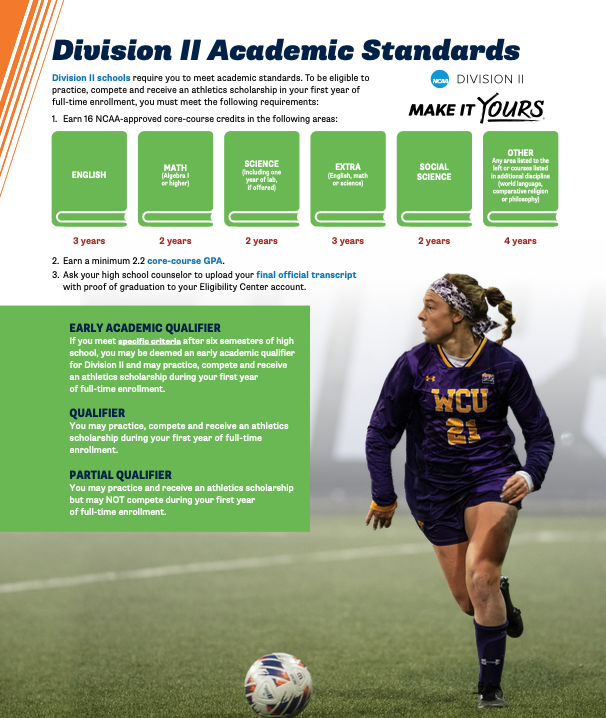Dealing with the NCAA Eligibility Center
Navigating the pathway to collegiate athletics involves several critical steps, one of which is ensuring eligibility through the NCAA Eligibility Center. This essential process verifies that high school athletes meet the necessary academic and amateurism standards to compete in NCAA Division I and Division II sports.
When is it actually necessary to complete the Eligibility Center process? This question often confuses many students. In my experience, the critical point at which the Eligibility Center becomes essential is when individuals from a school's athletics department, beyond just the coaches, start to get involved. This typically occurs during key moments such as an academic pre-read, a campus visit, or other instances where coaches are introducing staff members into the recruiting process. These scenarios signal that the recruitment is advancing to a more formal stage, requiring verification of academic and amateur status to ensure the student-athlete's eligibility and that all-important NCAA ID#. The ID is not necessary, all the way up until the moment that it’s very necessary, so it’s a good idea to just get the process done early on.
Here is some basic information and steps for students and families to help get through this sometimes tricky task.
Purpose of the NCAA Eligibility Center
Academic Eligibility: The NCAA Eligibility Center verifies that student-athletes have completed the required core courses in high school, achieved a minimum GPA, and met standardized test score requirements (SAT or ACT) to ensure they are prepared for college-level coursework.
Amateurism Certification: The center ensures that student-athletes have maintained their amateur status by not receiving any payment for their athletic skills, which is crucial for maintaining the integrity of college sports.
Steps to Register with the NCAA Eligibility Center
Create an Account:
Visit the NCAA Eligibility Center website (eligibilitycenter.org).
Click on the “Register” button to create a new account.
Choose between a Certification Account (required for Division I and II) or a Profile Page (for students considering Division III or undecided).
Provide Personal Information:
Fill out the necessary personal information, including name, address, date of birth, and contact details.
Enter details about your high school and graduation year.
Submit Academic Information:
Request your high school to send your official transcripts to the NCAA Eligibility Center.
This can be done through your counseling office. It is done very regularly at most high schools so counselors and staff will be very familiar with the process.
Ensure you have completed the required 16 core courses (for Division I) or 14 core courses (for Division II), covering English, math, natural or physical science, social science, foreign language, comparative religion, or philosophy.
PDFs from the NCAA are attached to the bottom of this post for DI and DII eligibility.
Report Test Scores:
Submit your SAT or ACT scores directly to the NCAA Eligibility Center using the code 9999.
This step is not necessary if a student is not reporting a test score and qualifies through their grades and GPA.
Complete Amateurism Questionnaire:
Answer questions about your sports participation history, including any teams you’ve played for, events you’ve participated in, and any financial compensation received.
Confirm your amateur status by ensuring you haven’t accepted any payment for athletic participation beyond permissible limits.
Pay the Registration Fee:
A fee is required to complete the registration process. Fee waivers are available for students who qualify for a fee waiver through their high school.
Final Certification
Once the Eligibility Center has reviewed your academic records and amateurism questionnaire, they will determine your eligibility status. You will receive one of the following statuses:
Certified: You meet all the academic and amateurism requirements and are eligible to compete in NCAA Division I or II sports.
Not Certified: You do not meet the necessary requirements and are ineligible to compete.
Partial Qualifier (Division II only): You meet some but not all of the requirements and may receive certain benefits but cannot compete in the first year.
The NCAA Eligibility Center plays an important role in the college athletics recruiting process, ensuring that student-athletes are academically prepared and maintain their amateur status. Understanding when to complete the Eligibility Center process is crucial. Typically, this becomes necessary when the recruitment advances to a stage where members of the school’s athletics department, beyond just the coaches, get involved—such as during an academic pre-read or a campus visit. By guiding student-athletes through the registration steps early and ensuring all necessary documentation is submitted, counselors can provide important support and guidance, while at the same time helping them relax and understand that the Eligibility Center step is not one that should cause stress.



